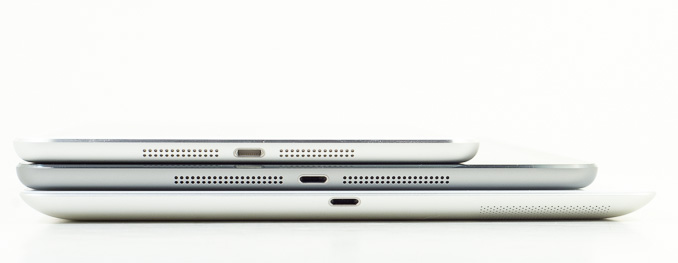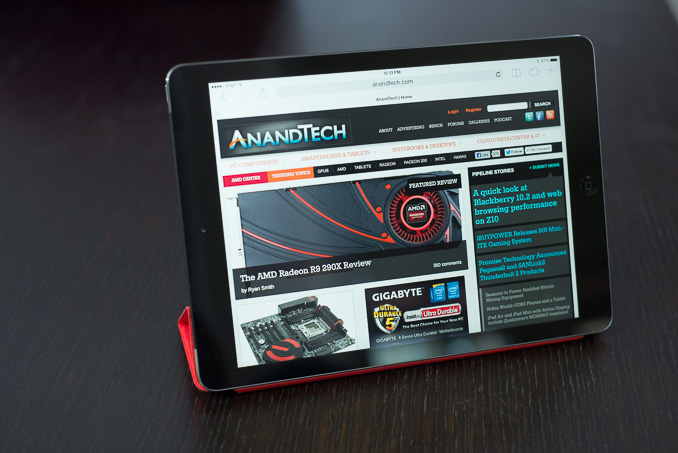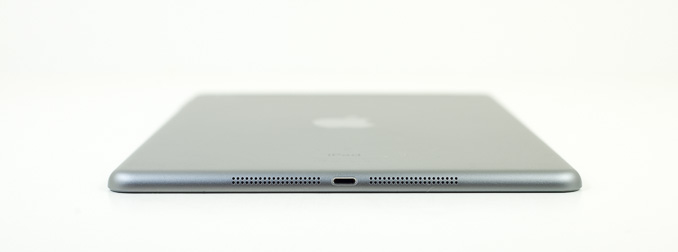The iPad Air Review
by Anand Lal Shimpi on October 29, 2013 9:00 PM ESTFinal Words
Two weeks ago I had all but written off the bigger iPad. It was too bulky and just no where near as portable as the iPad mini. Once the latter gets a Retina Display and equal hardware across the board, why would anyone consider the bigger model?
The iPad Air changed my perspective on all of that. It really does modernize the big iPad. While I suspect there are still going to be a lot of users who prefer the smaller form factor of the iPad mini with Retina Display, I do feel like there are those users who will continue to appreciate all of the benefits that go along with having a larger display. Text is easier to read, particularly on desktop versions of websites. Photos and videos are larger and thus more engaging as well. In the past there was this complex matrix of tradeoffs that you had to make between iPad and iPad mini. This generation, Apple does away with all of that.
All you need to do is pick your screen size. If you prefer the 9.7-inch form factor of the original iPad, the Air gets you as close as possible to a mini without giving up that display size.

From top to bottom: iPad mini, iPad Air, iPad 4
The name does the product justice in this case. In two hands or lightly propped up against something (palm, legs, chest), the iPad Air feels incredibly light - the weight just seems to disappear. The larger chassis doesn’t feel very dense at all. The in-hand feel of the device is really unlike any other iPad. It feels like a lightweight slate, rather than a heavy computing device. This is the iPad that Apple likely wanted to launch on day 1, it just took a bit over three years to get here.
Build and material quality are of course excellent. The iPad Air borrows much of the design language from the iPad mini, and makes the transition to a larger display quite nicely. The Air ends up looking a lot more modern than its predecessor.
Despite making the transition to a thinner touch and display stack, the iPad Air’s display is every bit as good as previous Retina Display iterations. Color accuracy remains best in class, delivering an out of box display experience that’s better than most systems, even at substantially higher price points. The only thing that the iPad Air leaves me wanting on the display front is a lower reflectance stack. Laminating the cover glass to the LCD panel is something that Apple does on both the iPhone and iMac, it’s time that the same feature is brought down to the iPad.
Apple’s decision to unify silicon across the iPhone 5s, iPad Air and iPad mini with Retina Display is an interesting one, but ultimately it doesn’t come with any real tradeoffs for iPad owners. Apple’s own 64-bit Cyclone cores are incredibly powerful, even more so than I originally expected when I reviewed the iPhone 5s. Apple seems to have built a bigger, higher performance CPU architecture than any other ARM player, including ARM itself. The design isn’t perfect, but it’s a completely different caliber performer than anything else it competes against. As such, Apple was completely justified in putting the A7 in both the iPhone 5s and the iPad Air. If anything, I’d argue that it might be overkill for the 5s given the device’s smaller battery, but my sensibilities soon get the best of me and remind me that more performance on tap is never a bad thing.
On the GPU front, Apple does increase performance over the iPad 4 as well - despite having a narrower memory bus. The increase in performance ranges from 40 - 70% depending on workload. I suspect we’re beginning to see some of the limits of 28nm here as Apple would’ve traditionally gone for an even larger GPU.
Despite having a smaller/thinner/lighter battery, battery life improves across the board compared to the 3rd and 4th generation iPads. Battery life in our web browsing, video playback and gaming workloads is better than either of the previous two iPads. Only the iPad 2,4 was able to deliver better battery life, but nothing with a Retina Display can match the iPad.
Cellular integration remains awesome on the iPad Air. With a single SKU covering 34 countries and no network operator lock, at least for those devices sold in the US, the LTE iPad Air is amazingly flexible from a network portability standpoint.
Improvements around the edges are nice as well. The inclusion of a second microphone can improve FaceTime HD calls in noisy environments, and faster WiFi is a nice addition.
My only complaints are limited to iOS 7, memory size and pricing. It’s clear that even on the fastest hardware Apple has to offer, iOS 7 isn’t always super smooth (particularly when using multitasking gestures to switch between apps) on an ultra high resolution device. The move to a 64-bit OS and applications makes a lot of sense, but with no corresponding increase in DRAM size Apple creates additional memory pressure on all of the A7 enabled devices. Finally, I’d love to see Apple update the default iPad configurations. Although 16GB is fine for a device that’s not going to be storing a ton of photos/videos locally, it would really be nice to get at least 32GB on the entry level iPad. The first complaint I suspect will be addressed over time. The second is a reality we just have to live with unfortunately, and the third won’t change until market dynamics force it to.
The iPad Air is the most significant upgrade to the 9.7-inch iPad in its history. It’s lighter, more portable, more usable and faster than any previous iPad. It doesn’t fundamentally change what you can do with a tablet, but if you’re in the market for one the iPad Air really is the best iPad to date. Competition is definitely more stiff among the smaller tablets thanks to the Nexus 7, but in the nearly 10-inch tablet space it seems like Apple is going to continue to enjoy a great position there.












444 Comments
View All Comments
sna2 - Wednesday, October 30, 2013 - link
wrong.Most flash sticks are eMMC and they operate at 100MB/s to 200MB/s which needs usb3.
Kristian Vättö - Wednesday, October 30, 2013 - link
Read speeds can easily exceed 100MB/s because reading from NAND is much faster than writing to it. Write speeds of 32GB or smaller flash devices can barely hit 40MB/s because the NAND itself can't write faster, and it's the write speeds that matter when syncing. Even if we're dealing with a full blown SATA SSD the write performance for 32GB models is around 40MB/s. Performance does scale with capacity so a 64GB or 128GB model will be faster but we are still far away from data rates over 100MB/s.fokka - Wednesday, October 30, 2013 - link
this, so much. i'm always astounded when people bring up that they wanna see (e.g.) usb3 in their next mobile device. as if there are any current devices scratching on the 30MB-mark which would be totally possible with usb2, if manufacturers wouldn't insist on implementing bargain-bin nand and even shittier usb-controllers.FCsean - Wednesday, October 30, 2013 - link
It would be stupid of them to put thunderbolt cables for iOS devices since more than half of the owners don't own a mac. USB 3.0 would be the way to go but not everyone has USB 3.0 so they're not yet wasting their money in manufacturing USB 3.0 cables since it's a lot more expensive to manufacture. I think it's two times more expensive.darkcrayon - Wednesday, October 30, 2013 - link
Not only that, but am I the only one who rarely syncs large amounts of data at a time anymore with an iPad? Most of the sync is done wirelessly in small amounts over time. The only time I need a full many gig sync is when I upgrade devices or (extremely rarely) need to do a full wipe. Faster syncing would be nice but it's just not the daily process it used to be.Sushisamurai - Wednesday, October 30, 2013 - link
...yeah.... I don't know about u guys, but is wireless sync all the time now, either comp to iPad or iPad OTA with iCloud, wiping my device q3-6 months. I have no issues with restoring a full 32GB, and it's pretty quick... Down speeds of 10MB/s wifi, 40MB/s LTE (OTA for both), but if I were to sync via comp, a HDD to NAND is pretty abysmal speeds. Not to mention, if it was TB/USB3 u're going to have a thickness increase, and I'd rather not. Inductive charging, if u recall, is a slow, inefficient form of charging. I'd rather have my full 2A going into my iPad versuses drawing the same 12W but giving me the equivalent of 6W wirelessly. NFC and tablets? Okayyyyyyyy there.petersellers - Wednesday, October 30, 2013 - link
Doubly stupid considering that thunderbolt runs on PCI express lanes and PCI express is not present in any of these devicesekotan - Wednesday, October 30, 2013 - link
You can't have Thunderbolt without a corresponding Intel chipset, so forget about it on any ARM tablet. Also, the NAND used by these devices is so slow that having Thunderbolt would be utterly pointless. Most can't even saturate USB 2.0, never mind USB 3.0. Only the most recent Apple mobile devices have NAND fast enough to saturate USB 2.0.abazigal - Saturday, November 2, 2013 - link
I restored my 5s recently (coming from a 32gb 4s). The whole process took 1-2 minutes at most. Just plug in and click a button. Likewise, few people are so fastidious as to back up their devices via iTunes manually every day. The time savings from going thunderbolt is so minimal that unless your life somehow revolves around restoring thousands of these devices every day, I don't feel the benefits are worth the added cost.iSayuSay - Sunday, November 3, 2013 - link
And how Thunderbolt sync would help? Did you realize how much is the transfer rate from NAND flash in the iPad/iPhone? No more than 16MB/s, it's not SSD per say. It's a slow internal memory it becomes bottleneck. So as long as Apple do not change those (I doubt it will ever for the next 5 years), there's no point of porting Lightning to Thunderbolt or even USB 3.0 .. Ever.